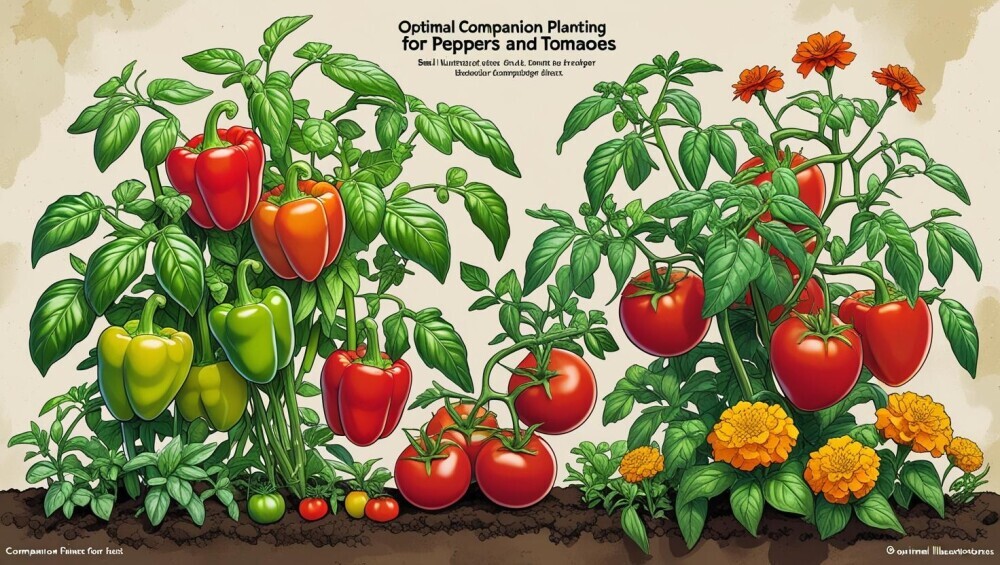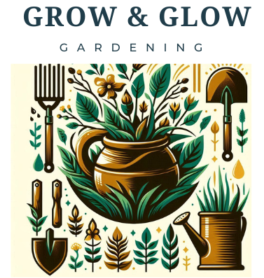 Companion planting is a bit of gardening magic that aligns nature’s abilities with a gardener’s needs. Imagine having plant buddies that not only play well together but also help each other thrive. That’s what this age-old practice is all about—pairing up plants that mutually benefit from each other’s presence. From improved growth to natural pest control, the perks are plenty.
Companion planting is a bit of gardening magic that aligns nature’s abilities with a gardener’s needs. Imagine having plant buddies that not only play well together but also help each other thrive. That’s what this age-old practice is all about—pairing up plants that mutually benefit from each other’s presence. From improved growth to natural pest control, the perks are plenty.
For tomatoes and peppers, which are often the stars of the summer garden, having the right companions can make a significant difference. Some plants act like bodyguards, keeping pests at bay, while others enhance soil nutrients or improve flavor. It’s about finding the right mix!
Before you start pairing up plants like matchmakers, it’s crucial to know your garden. Soil quality, sunlight, and space play huge roles. If your ground is solid and nutrient-rich, you’re off to a good start. Consider the environmental factors too—weather patterns and water availability can shift the dynamics.
Creating a thriving garden is about more than just the plants you see. A biodiverse garden, where insects, microbes, and plants form an ecosystem, can be your best ally. This biodiversity not only ensures healthier plants but also promotes a more resilient garden. Think beyond the plant and ponder the ecosystem.
Avoiding Planting Pitfalls: What to Avoid in Your Vegetable Garden
Ever heard of allelopathy? It’s when some plants decide to play dirty, throwing around chemicals to fend off competitors. This can spell disaster for your tomatoes and peppers if the wrong plants are nearby. Knowing who not to plant together can save you from a lot of heartache.
While companion plants can boost your garden’s growth, getting them wrong can also mean trouble. Sticking certain plants together might sound great, but be cautious of those that could stunt each other’s growth or attract unwanted pests. A common mistake is overcrowding, which leads to competition for resources and poor air circulation.
Observing your garden’s dynamics regularly helps in identifying and fixing unwanted plant interactions. If plants aren’t thriving, or pests seem to be everywhere, retrace your steps. Consider if allelopathic plants are causing stress to your favorites. Adjust as needed to restore harmony.
Success in the garden sometimes means going with the flow. Pay attention to seasons and local climate—it can dictate which plants go in when. Rotating crops and adjusting plant pairings throughout the year keep soil healthy and pests guessing. Keeping this flexibility can prevent issues before they start.
Top Companion Plants for Tomatoes: Elevate Growth and Flavor
Basil is the rockstar sidekick for tomatoes. It doesn’t just enhance flavor; some say it helps tomatoes grow more robustly. Plus, its aroma can make pest insects think twice about setting up shop.
Then there are marigolds. These brightly colored blooms aren’t just eye candy—their scent deters nematodes and other pests. This could cut down on the need for chemical interventions, keeping your garden as natural as possible.
Onions and their relatives, like chives, are another great team player. They’re fantastic at keeping disease-causing elements away, thanks to their sulfur compounds. It’s like setting up a protective shield around your tomatoes.
Carrots might seem an unusual pick, but these root vegetables use different soil depths for their growth, complementing tomatoes nicely. They improve soil structure, giving tomato roots room to breathe.
Peppers’ Perfect Partners: Boost Growth and Pest Resistance
Beetroot might just be the underground hero your peppers need. These roots tap into soil nutrients differently, ensuring both plants get what they need without stepping on each other’s toes.
Parsley is more than just a garnish. In the garden, it attracts beneficial insects that are natural predators to pesky bugs, giving peppers a fighting chance against infestations.
Spinach can serve a dual purpose as a ground cover and temperature regulator. It shields soil from harsh sun, keeping the ground moist and cool, which peppers appreciate.
Radishes offer a unique synergy. They grow quickly, breaking up the soil for pepper roots, plus they can keep pests distracted with their tasty greens, ensuring your peppers stay in the spotlight.

I really enjoyed how this article breaks down companion planting for tomatoes and peppers—it’s more than just garden science, it’s like building a community of plants that support each other! I’ve always been curious about using basil and marigolds together—have you noticed a big difference in pest control or flavor with specific pairings in your own garden?
Thank you for your kind words! I’m happy to know that you enjoyed how this article breaks down companion planting for tomatoes and peppers. You are right that it’s like building a community of plants that support each other!
As you comment on that, you’ve always been curious about using basil and marigold together, not only smell good, but they have lots of benefits and are a flavor booster for tomatoes, and offer strong protection against pests. Marigolds are known for their beautiful flowers however, this plant offers a wide range of protection to tomatoes and peppers. It has amazing pest-repelling properties, especially against nematodes and aphids, which can be a real game changer for your pepper and tomato plants!
I’ve seen a big difference in both the infestation and reduction of creeping pests’ damage to my crop. Give it a try and enjoy the delightful blooms and delicious harvests!
Happy gardening!
Garfield
Yo, Garfield,
OMG, your article about companion planting for tomatoes and peppers is seriously awesome! You made it so easy to understand, and I get the whole biodiversity and allelopathy stuff now. Like, whoa, plants are way more complicated than I thought!
The part about basil being a “rockstar sidekick” for tomatoes and marigolds scaring off bugs was super cool. It’s wild how nature just figures things out on its own.
Now I’m thinking about trying this in my garden (when I get one, in the future, of course!). Have you used these companion plants yourself? Did they make your tomatoes and peppers, like, epic?
Also, how do you even arrange them? Should I do rows, or just put them all together?
Seriously, this article was so helpful and inspiring. I’m pumped to try some of these tips! Thanks for sharing your plant wisdom!
Eric
Erick.
Thank you for your kind words! I’m thrilled to hear you find this article seriously awesome that you also find it easy to understand. You see, plants can become very complicated when you don’t understand much about the plant you’re trying to grow
Basil is the “rockstar sidekick,” while marigolds scare off bugs. That’s its true nature as it way to figure out things on its own!
I’m happy to hear that you are thinking about trying this in your garden. I have tried this technique and was surprised by the result, It’s a good idea to share our gardening experience so that one can expand on their gardening wisdom by doing self-experiment on plants!
Here is the answer to your question: Basil- The superstar Partner.
Planting Strategy
1. Plant basil 12-18 inches away from your tomato plants or pepper plants. Try Genovese for classic flavor or ‘African Blue’ for stunning purple flowers that beneficial insects adore.
Bonus: You will have fresh basil for all those tomatoes you’ll be harvesting!
Marigolds- Nature’s Pest Control
2. Plant marigolds in a border around your tomato bed and pepper, or scatter them throughout. The more, the better! Choose compact varieties, such as the ‘Petite’ series, that won’t compete for space.
Again, thank you for your kind words, and happy gardening when your time comes!
Garfield